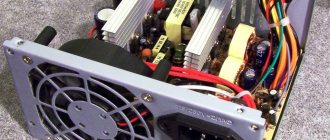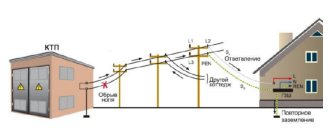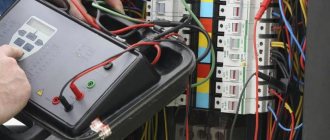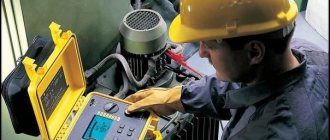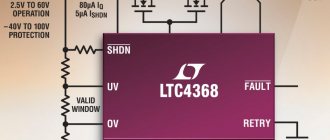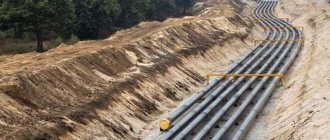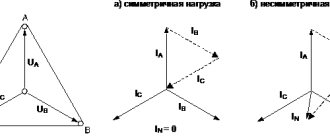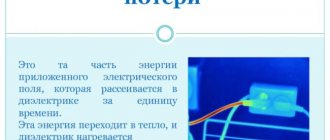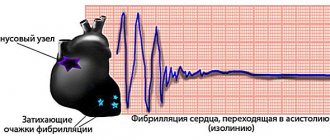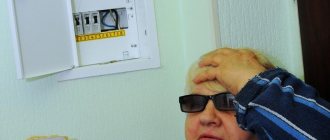Overloads are abnormal situations in the operation of the electrical network that you may not pay attention to: minor malfunctions in the operation of household electrical appliances, flickering lamps in lighting fixtures and other insignificant problems.
The real danger is that even the most minor and short-term overloads can lead to very serious consequences, including fires in the wiring and a fire in the room, if the electrical wiring is old and worn out, and household electrical appliances are used in violation of the rules of safe operation.
Such unpleasant and sometimes tragic consequences of overloads in the electrical network can be easily avoided if you understand the causes of overloads and know how to protect against them. It is these issues that our article is devoted to.
Excessive power grid load
Simultaneously connecting several powerful consumers to one outlet leads to excessive load on the socket itself and the electrical wire feeding it. The result of such a connection may be melting of the housing and parts of the electrical outlet or even fire of the electrical wiring.
Let's consider a specific example: an electric oven and a washing machine are connected to a two-socket outlet at the same time. Both devices can require up to 4 kilowatts of power.
If the electrical system is protected by a standard 10 amp circuit breaker, then of course it will trip and open the circuit. The current strength of 10 amperes in terms of power (in a network with a rated voltage of 220V) will be 2.2 kW.
It is quite clear why in the described situation the machine worked, protecting the network from overload.
In a rash attempt to “overthink” the laws of physics, the user installs a more powerful 20-amp circuit breaker, which will allow two powerful consumers to be connected to the outlet at the same time, but in this case both the outlet and the wire feeding it will overheat and begin to smoke. The fact is that the socket and electrical wiring are also designed for the standard 10 amperes.
The meaning of the above example is that if there is a need to simultaneously turn on several powerful consumers, then you need to take care of replacing the electrical wiring with wires corresponding to the increased load cross-section, installing a socket that is more resistant to overloads, and using a suitable circuit breaker.
Ideally, such issues are resolved at the initial stages of building a house, or before major renovations. You should consider the layout of electrical appliances in your home and divide them into logical groups.
Provide for the installation of separate power branches for each of the groups, or individual wiring for particularly powerful consumers. It is necessary to calculate in advance the cross-section and length of the wires for each of the branches, purchase the required number of suitable sockets and circuit breakers.
Only in this way can you reliably and effectively protect electrical networks from overloads, electrical equipment from damage, and homes from fires.
What can you do about network congestion?
If you notice slower internet speeds due to congestion on your home network, there are a few things you can try.
The first step is to check what speed you're actually getting by using a free speed test service like fast.com. Take the test several times a day, write down the numbers you get and take the average. Then check with your provider's data plan and see if the values match the speed you're paying for. If they don't, call your provider and let them know. They may tell you that you have an old router or modem that needs to be upgraded. However, if the numbers match, you may need to increase the capacity coming into your home. This will cost you more each month, but it can open up the data channel wide enough that you no longer experience latency. Going back to the traffic analogy, it would be like creating a big circular driveway so cars could pass each other and move better.
Another way to reduce slowdowns due to network congestion is to connect your important devices directly to your router using a network cable, which provides the fastest and most stable connection to your devices. Even if your computer doesn't have an Ethernet port, you can buy USB adapters to make the connection easier.
Additionally, most modern routers now broadcast in two different frequency bands: 2.4 GHz and 5 GHz. The 2.4 GHz bandwidth is slower than the 5 GHz spectrum, but it can reach further. However, most common Wi-Fi devices still operate on the 2.4GHz frequency band, so they may simply become busier. So, if you have any devices that are within range of your router and can receive a reliable 5GHz signal, you can log into your router and assign that portion of bandwidth to those devices. You will need to follow specific instructions for your modem, but the process is not complicated and can usually be found by searching online, using your modem's app, or checking your user manual if you still have one.
Finally, if you're still experiencing slowdowns, you can create an internet schedule for your home, specifying who can use your connection for different activities at different times. By allocating demand to data-intensive tasks, you may just experience an improvement in speed. Plus, while some family members may have to wait to connect to the Internet until it's their turn, if you have a good cellular connection at home, they can use it to surf, chat, and stream, further reducing the strain on the bandwidth of your home. pipeline.
Wear and tear of electrical wiring
Old wires, twisted, bent, pinched many times and in many places, are the root cause of all problems.
In places of bends and pinches, the cross-section of the wire is reduced. Throughput is reduced. The insulating sheath of the wires dries out and cracks. A short circuit and associated overloads and wiring fires are just a matter of time.
So:
- Conduct timely inspection, repair and replacement of outdated electrical wiring;
- Do not skimp on high-quality electrical equipment and protection devices for electrical equipment and networks;
- Study the relevant technical literature, or better yet, use the services of professional electricians for periodic inspections and routine maintenance of your electrical networks and electrical equipment.
Protect your life and health, as well as the life and health of people living in your neighborhood from accidents and fires.
Great Encyclopedia of Oil and Gas
Page 1
Overloading of electrical networks, machines and devices, resulting in heating of electrical equipment and electrical wiring sections, can also serve as a source of fire. [1]
Overload of electrical networks, machines and devices can also be determined by measuring their temperature and comparing it with the maximum permissible. For this purpose, thermometers, thermocouples and various temperature indicators are used. [2]
Instantaneous electric water heaters require significant power, which leads to overload of electrical networks, so their scope of application is limited only to industrial and public buildings. [3]
The disadvantage of fuses is that they allow, without blowing, an overload of the electrical network with a current that is sometimes 1 to 5 times the rated current of the fuse.
Important
Recently, circuit breakers in the form of plugs have appeared on sale, which are screwed into their place.
Such switches open the circuit even when the current slightly exceeds the rated current. Therefore, they do not need to be replaced and they are eternal guards against any violations on the network. If the machine has turned off the network, then to turn it back on you need to press the power button.
Before doing this, turn off all electrical appliances connected to the network that could cause overload and short circuit. [4]
Such switches open the circuit even when the current slightly exceeds the rated current. Therefore, they do not need to be replaced and they are eternal guards against any violations on the network. [5]
During operation of intra-shop electrical networks, electrical loads, which may vary, are monitored.
Advice
If the inspections show that overloads of electrical networks are systematic, then it is necessary to take measures to unload the networks or to reconstruct them. [6]
However, the thermal effect of electric current is not always beneficial. If electric current is used ineptly and incorrectly, its thermal effect can cause harm. So, due to an overload of the electrical network, the insulation of the wires burns out; A short circuit occurs in the electric motor winding, and as a result of overload, the electric motor fails. [8]
If the inspections show that overloads of electrical networks are systematic, then it is necessary to take measures to unload the networks or to reconstruct them. [9]
During operation of intra-shop electrical networks, their current load is also monitored. This is determined by the fact that electrical loads can change for various reasons.
Overloading electrical networks for a long time leads to unwanted overheating of the electrical insulation.
note
If the checks performed show that overloads of electrical networks are systematic, then measures must be taken to unload the networks or to strengthen them. [10]
Network overloads over a long period of time lead to unwanted overheating of the electrical insulation.
If the checks performed show that overloads of electrical networks are systematic, then measures must be taken to unload the networks or to strengthen them. [eleven]
Pages: 1
The main causes of power surges in the network
Various events can lead to a sharp change in voltage levels - from technical issues to weather conditions. In many cases, there is no point in looking for the “culprits,” but some directly depend on the work of the company that supplies the building with electricity.
Thunderstorms
A lightning strike on a power line causes severe overvoltage in the network.
In the old days, during rain and thunderstorms, all equipment was disconnected from the power supply, the sockets were removed from the network. Household equipment did not have protection sensors, so action was appropriate. Today, most devices have safety modules that protect against power surges and sudden changes.
However, electricians recommend turning off the computer and TV. When thunderclouds occur, lightning discharge reaches billions of volts. Modern protection systems reduce the risk of a direct strike to electrical wiring, but do not completely eliminate it. Cables installed in residential areas are more often affected. Such lines are laid as desired, sometimes in violation of the norms. Routers, switches, a computer with a hard drive and a monitor, and other network equipment can break down.
Atmospheric overvoltage
A situation similar to a thunderstorm - a voltage difference accumulates in the atmosphere, causing a lightning discharge. If the shock hits an electrical installation directly or in close proximity to it, a sharp surge in voltage will occur in the networks. Low-power installations burn out first.
There are induced (next to the block) and direct throw. In the second case, in addition to a power surge, mechanical breakdowns occur - racks and overhead line supports are split. There is a danger for household appliances and appliances in every case.
Technogenic reasons
Power surges
Most often, the reasons for sudden changes are technical problems and human factors. At home and in production, they do not always monitor the maximum load of the network and connect a lot of devices at the same time, which causes a surge in electricity. Devices without protection will burn out. Other similar situations include:
- Overload at a transformer substation - most of the projects were formed more than 30 years ago and were not designed for the current amount of electricity consumed.
- Accidents on power lines and cable networks occur due to the general condition of wires, equipment and poor weather conditions.
- Malfunction or poor contact with the neutral wire.
- Problems on the internal part of the electrical wiring (irregularities during installation, poor-quality or faulty equipment).
- Being near large industrial and other facilities (shopping centers, workshops, etc.) with high electricity consumption - when turning equipment on and off, a sharp voltage drop occurs on neighboring networks, including.
The essence of the dispute
On the night of August 28-29, 2014, as a result of an accident on a power line, which caused a voltage drop in the power grid, the belongings of Ts.R., Ts.A., Ts.B. were out of order. and A.T. (hereinafter referred to as the plaintiffs) household electrical appliances. In September of the same year, they sent to the network company “I” (hereinafter referred to as the defendant) an application for compensation for damage caused as a result of a voltage drop in the electrical network. The energy supply organization left the statement without a response.
Next, the consumers went to court with a demand to recover from the defendant material damages for broken household appliances, the costs of conducting an examination, compensation for moral damages and a fine for failure to fulfill the consumer’s legal demands.
The court of first instance, having studied the report of the network company, which testified that the short circuit of the high-voltage lines occurred as a result of a tree falling on the power line, the inspection report of Rospotrebnadzor and the conclusion of the household appliance repair shop, confirming damage to the equipment due to network overvoltage, came to the conclusion the conclusion that the plaintiffs suffered damage as a result of the defendant supplying electricity of inadequate quality.
Having disagreed with the decision of the city court, the defendant filed an appeal.
The appellate court agreed with the defendant's complaint. He pointed out that the victims in this dispute did not provide evidence that the damaged property belonged to them on the date of the accident and became unusable due to a voltage drop on August 29. The court also noted that the inspection report carried out by Rospotrebnadzor cannot serve as evidence, since it does not meet the requirements for such documents, since it does not contain the signatures of the persons participating in the inspection. Please note that based on the results of each inspection carried out by Rospotrebnadzor, an act must be drawn up in a standard form approved by Order of the Ministry of Economic Development of Russia dated April 30, 2009 No. 141 (,). The inspection report requires the signature of the Rospotrebnadzor officials who conducted the inspection (,). According to the court, if the inspection was carried out by several persons, then the signature on the act of only one of them is not enough.
Effect of a short circuit on electrical equipment
Short circuit – emergency operation mode for the electrical network. When it occurs, it has two effects on electrical equipment simultaneously:
- electrodynamic;
- thermal.
According to the laws of physics, when current passes through two conductors located nearby, they interact with each other. Depending on the direction of the current, they either attract or repel. As the current increases and the distance decreases, the interaction strength increases.
On this principle, the electrodynamic effect of short-circuit current on buses, wires, and windings of electrical machines occurs. At substations and other power facilities, where fault current values reach tens and hundreds of thousands of amperes, after a short circuit the equipment may become completely unusable due to mechanical damage. In this case, the short circuit itself may occur somewhere to the side.
Thermal effects are based on the heating of conductors when electric current passes through them. In this case, the temperature sometimes rises so much that the wires or busbars melt.
In domestic conditions, the thermal effect of a short circuit is more pronounced; the dynamic effect can be ignored due to the small current values.
Overheat
Overheating of the power switch is considered dangerous if the temperature of the crystals exceeds the limit value Tjmax specified by their manufacturer (for modern silicon devices Tjmax = +150...+175 °C).
During inverter operation, overheating may result from increased power dissipation caused by overcurrent or control circuit error. The most common cause of an abnormal increase in the temperature of the power stage is a malfunction of the cooling system.
Methods of protection
Voltage relay
It is impossible to completely exclude the possibility of differences. If power surges are constant, there are several options to protect expensive household appliances. Can be used for most known types of devices.
Voltage control relay
The device helps solve the problem of sudden energy surges in the network. If there is a deviation from the set values, the device turns off the equipment. After the voltage supply returns to the established norm, the relay starts supplying electricity again.
This method helps only in some situations - a break in the zero contact, a city transport cable (tram, trolleybus) getting into the power lines. When struck by lightning and during periods of atmospheric overvoltage, the device is almost useless.
You can install it yourself by following the step-by-step instructions.
Uninterruptible power supplies
These devices are not protective, but together with them they help to avoid burnout of devices, but not to remain in complete isolation until the normal voltage level is restored. Providing electricity to an entire house or apartment is impractical and economically ineffective. It is enough to connect a separate section of wires (for example, for lighting).
Surge Protectors
If the voltage in the apartment fluctuates (surges, spikes, etc.), it is recommended to use special stabilizers. The maximum effect is achieved when the input voltage “sags”. They help with weak surges in the network, but cannot cope with strong impulses (for example, lightning strikes). Electricians recommend use in tandem with a relay.
Lightning surge protection
Protection of overhead power lines from atmospheric overvoltage
Atmospheric overvoltage and lightning cause household appliances to burn out. You can avoid unpleasant consequences if you install special voltage limiters at the input
It is especially important to use devices in private homes. Without protection from lightning surges during bad weather conditions, it is necessary to disconnect all home devices from the network (pull them out of the socket), turn off the lights
These devices protect only in the event of high-voltage surges. During minor power outages, they are useless.
Content
- 1 Network capacity
- 2 Congestive collapse
- 3 Overload control 3.1 Theory of overload control
- 3.2 Classification of congestion control algorithms
- 4.1 Practical prevention of network congestion
- 5.1 Radio links

